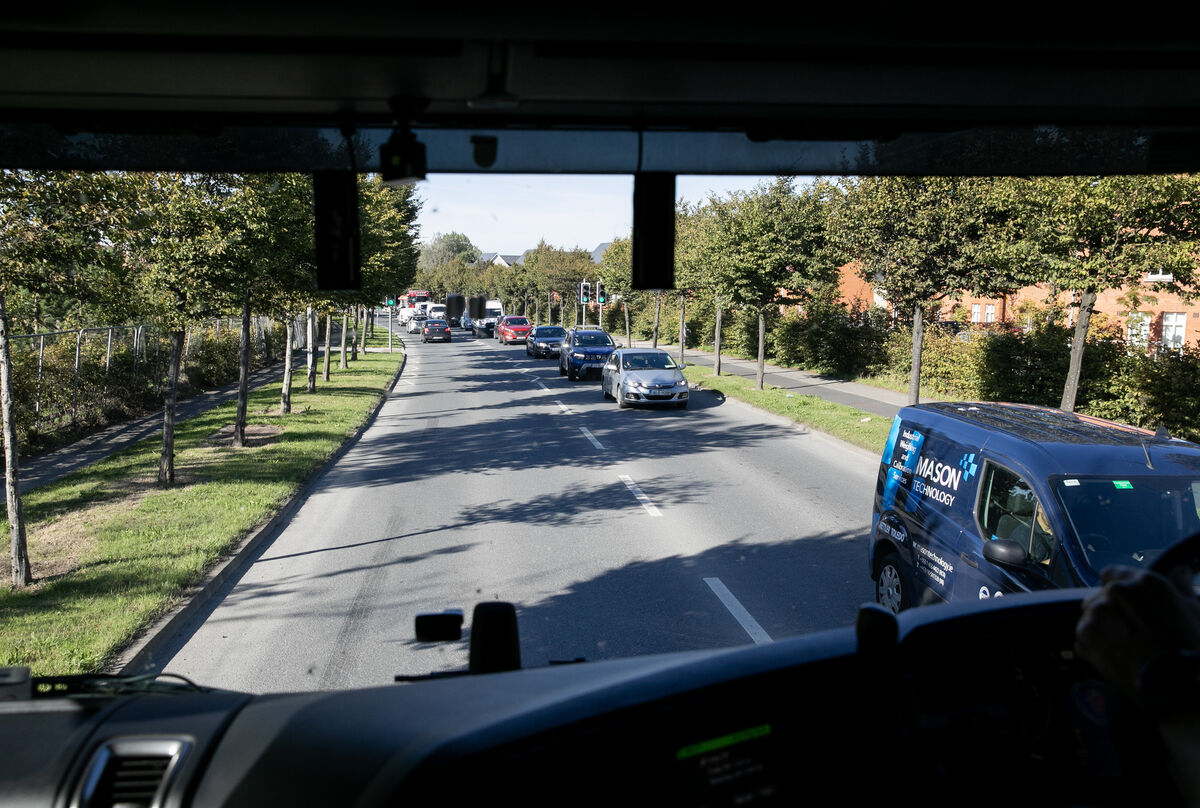'We’re not trying to hide this': Gardaí using unmarked HGV to detect bad driver behaviour

Inspector Peter Woods from the Garda Road Policing unit with the new observation vehicle.
"There’s a lot of interest in this from gardaí all over the country in getting it into their division. I can see it being rolled out nationally very soon.”
So says Inspector Peter Woods as he navigates a plain white truck, the latest weapon gardaí have in the fight to save lives on the road.
As it drives along the N7, the vehicle is one of the most nondescript vehicles imaginable.
One you would not take much heed of. It certainly does not stand out.
You’re certainly not going to expect to get pulled over by one, and get dished out some penalty points. But gardaí are now telling motorists to be wary of exactly that.
With road deaths on the rise, all the policymakers have said every possible lever must be pulled to try to reverse the worrying trends.
Garda Commissioner Drew Harris promised an Oireachtas committee in May an “innovation” was on its way to help gardaí detect distracted driving on the roads. And this “innovation” is so very simple.
“It’s a very straightforward concept,” Insp Woods said.

“Operation Iompair is a new initiative to enhance our road policing capabilities on the networks throughout Ireland. The elevated position we have in the tractor unit of this HGV allows us to see into all forms of transport on the roads.
“Other trucks, other high-sided vehicles and we can also see down into cars and see motorists committing offences such as holding a mobile phone, not wearing a seat belt or engaging in any other behaviour which might distract their attention and result in serious injury or fatal road traffic collisions.”
Having met Inspector Woods and his colleagues at an equally nondescript rest stop on the outskirts of Dublin, the set off for a ride-along to see this new operation in action.
Last year, gardaí issued more than 160,000 fixed-charge penalty notices for driving infringements, most of which were for speeding and holding a mobile phone.
While the number of fatal crashes remains so stubbornly high in Ireland, Insp Woods said having such a vantage point to detect drivers breaking the law makes things a “lot easier”.
“A lot of the seatbelt offences we’re getting are other truckers,” he said. “They’re more difficult to detect in a normal patrol vehicle because you can’t see up as well as you can in this vehicle.
The way it works is that there are two gardaí in the unmarked truck. Both, however, are wearing full Garda uniform to be able to identify themselves to other motorists. The truck is also equipped with siren lights that can be turned on if needed.
The garda in the passenger seat is in effect “the spotter”. They can peer down into cars and if they detect an offence, they radio in to a garda who is driving another car behind them who then proceeds to pull over the motorist in question.
“We’re not trying to hide this," Insp Woods said. “We make the distinction that it’s unmarked rather than a covert vehicle. You know, we’re wearing uniform. If we come up alongside something, we identify ourselves as gardaí. It’s just an advantage for us to be able to get closer to people before they spot us.”
Robert Griffin is a garda sergeant in the roads policing unit based out of Dublin Castle.

Following behind in an unmarked Garda car, Sgt Griffin is radioed by the “spotter” when he sees a motorist driving his car with a mobile phone up to his ear.
When safe to do so, the motorist is pulled over and told what gardaí have just seen. That man will end the day with a fine and three penalty points.
Sgt Griffin said this way of doing it is certainly “not the norm”. But he said he and his colleagues had found it very beneficial so far and believe it will act as a good deterrent to people using their phone or not wearing their seatbelt.
“We can’t be on all roads at all times,” he said. “But if people are worried about us being on the roads, then it might change their behaviour and drive safely, which in turn reduces the amount of fatalities and serious injuries on the roads. That’s the goal. To make sure everyone gets home safely.”
All the gardaí taking part in this operation agree something has changed in driver behaviour since covid-19. Such factors have also been mentioned the Road Safety Authority as a potential reason why fatalities have risen.
During the ride-along, gardaí recall seeing all sorts of driver behaviour, such as some shaving, doing their make-up or even having their dog on their lap while driving.
Sgt Griffin said a deterioration in driver behaviour is something he has certainly noticed and remarked: “It’s like we forgot how to drive.”
Finding the reason behind the change in driver behaviour is a different matter, with Inspector Woods remarking “there’s a dissertation in that”.

Sgt Griffin said initiatives like this were important as they are all about trying to keep people safe on the roads.
“Fatalities on roads... seeing that sort of stuff will haunt you for a long time,” he said. “But the worst part of it is going to tell somebody whose family member what you’ve just witnessed and asking them to accompany us to the morgue to identify their loved one.
“That’s something if I can, I would pay good money to never have to do that again. It’s horrendous. So if we can do anything to prevent any garda having to do that, it’s worth doing.”
The operation has only been rolled out for a handful of days so far, mostly in Dublin and also in Naas. Every time they have gone out on this operation lasting six to eight hours, it has resulted in “upwards” of 30 detections of motorists breaking the law.
Away from speed vans and checkpoints, gardaí believe this initiative can also be good deterrent for road users to ensure they abide by the law.
It remains a pilot project at the moment but such is the enthusiasm of the gardaí who have worked on it so far, it is expected the initiative will be rolled out across the country, including in Cork, with more HGV vehicles before long.
Insp Woods added: “Based on the success we had with this, I would envisage it being rolled out nationally. And possible a couple more track units and maybe one left permanently in the south, another in the west or north.”










